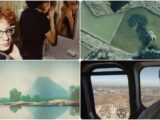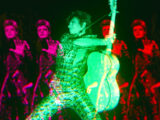Rodney Evans didn’t make Vision Portraits to inspire you. He made it to better understand himself, his artistry, and his deteriorating eyesight. If you walk away inspired, so be it, but the film, which tells the stories of blind and visually impaired artists, is far from inspiration porn. In fact, it may be the antithesis.
Exploitative and misguided, inspiration porn is the portrayal of people with disabilities as being inspirational solely on the basis of their disability. It’s made for the consumption of able-bodied audiences. In Vision Portraits, Evans appears acutely aware of this dangerous trope, circumventing it every chance he gets. “In making this film,” he writes in the movie’s press notes, “my aim is to bring greater awareness and honest portrayals of members of the disabled community. […] This film is also a way of reaching out but also reaching within.”
Evans does a marvelous job of “reaching within” both his psyche and his community, giving us passage into an experience most would consider unimaginable. Vision Portraits chronicles, with compassion and curiosity, the artistic journeys of four artists — a photographer, a writer, a dancer, and a filmmaker (Evans himself) — who are blind or visually impaired. Instead of pandering for our sympathy, Evans earns our empathy with his masterful storytelling.
He presents the subjects deftly, in all cases ceding the floor to the artist in focus, allowing them to tell their own stories. Each offers unique insight. John Dugdale, a photographer with only a sliver of his sight, emphasizes the importance of collaborative art and the power of imagination. Ryan Knighton, a blind writer, insists that blindness is a point of view in itself and that narrating your own life is a path to power. Kayla Hamilton, a dancer with sight in one eye, delivers what may be the film’s thesis: “value difference.”
Evans, who is best known for writing and directing the Sundance-winning drama Brother to Brother, has a specific situation: his gradually worsening vision pits him in a race against time to learn from others as he prepares for blindness. With Dugale, Knighton, and Hamilton, Evans considers issues like disclosing with confidence, managing expectations, and embracing limitations.
Vision Portraits speaks to the disabled experience — as well as to our culture’s pervasive ableism — with honesty and grace. Evans and his fellow artists lament the exhaustion and frustration that are inherent to living as a person with a disability in a world built for the able-bodied. But they also find strength in rejecting the pressure to “pass” as sighted.
“Trying to compensate and anticipate and retrofit — I just don’t want to do it anymore,” says Knighton. When it comes to accommodations, “Don’t pretend,” says Hamilton. She admits it can be hard for her to keep time with dancers to her left or to spot herself, and she allows herself the space to be honest about her needs. “I keep asking myself the question when I dance: ‘Who am I pretending for?’ If that’s what I need, that’s what I need to give myself.”
At a trim 78 minutes, the film excels in its braided structure, weaving Evans’ personal story in with those of his fellow artists. He was initially hesitant to include himself in the film. “I was afraid of the stigmas that might negatively affect future career possibilities,” he admits. “For a long time that’s why I didn’t want to be a part of the film. Because I was afraid to be visually represented on screen with a cane as a visually impaired individual. Then it just started to feel disingenuous to not be part of the film.”
It’s a great fortune that Evans decided to include himself in Vision Portraits. He acts as a simultaneous student and teacher, learning from those he enlists to help tell the story of blindness and educating viewers about the everyday experience of living with a visual impairment.
Evans is also a gifted director, using multimedia storytelling to reflect the multidisciplinary character of the film, as each chapter centers on a different art form. Evocative sound design, impressionistic cinematography, scientific imaging, and still photographs all work together with interviews to create a rich and immersive cinematic experience. According to the film’s press notes, the team behind Vision Portraits also took great pains when considering the issue of accessibility, ensuring that detailed audio description channels are available for visually impaired and blind audience members.
Vision Portraits is proof that people with disabilities must be given space to tell their own stories. So many of the depictions of disability we see on screen are refracted through the gazes of able-bodied creators — flattened, simplified, and diminished. Evans combats the scourge of inspiration porn by embracing the complexity, intensity, and contradictions that are inherent to the experience of disability.
Through the lens of visual impairment, Evans makes a definitive statement about all disability, and about the state of individuals with disabilities in America — the pressures of passing, the need for representation, and the difficulties navigating an exclusionary world. Vision Portraits is an extraordinary film and a desperately needed statement, one that gives a voice to the one in five Americans that live with a disability.




